Opto-Acoustic Laboratory
|
Department: Department of Ultrasonic Methods Head: Ing. Pavla Stoklasová, Ph.D. |
|
The Opto-acoustic laboratory is primarily focused on developing experimental techniques for studying the elasticity of new materials. The principles of physical acoustics are utilized to investigate elastic properties in metals, intermetallics, ceramics, composites, and functional materials (ferroics). Another aim is to characterize their structural changes (for example, during the phase transformations). The specialization field is the propagation of acoustic (ultrasonic) waves in anisotropic/nonlinear/attenuating materials, materials with microstructure, materials exhibiting phase transformation, thin films, and other materials with extraordinary elastic or acoustic properties. The experimental research is carried out using opto-acoustic methods such as Brillouin spectroscopy or Transient grating spectroscopy. |
Head:
Ing. Pavla Stoklasová, Ph.D.
Researchers:
Mgr. Michaela Janovská, Dr.
Ing. David Mareš, Ph.D.
Ing. Martin Ševčík, Ph.D.
Students:
Ing. Tomáš Grabec
Ing. Kristýna Zoubková
Technical stuff:
Ing. Jan Zídek
Martin Crhán
Development of the Transient grating spectroscopy methodology
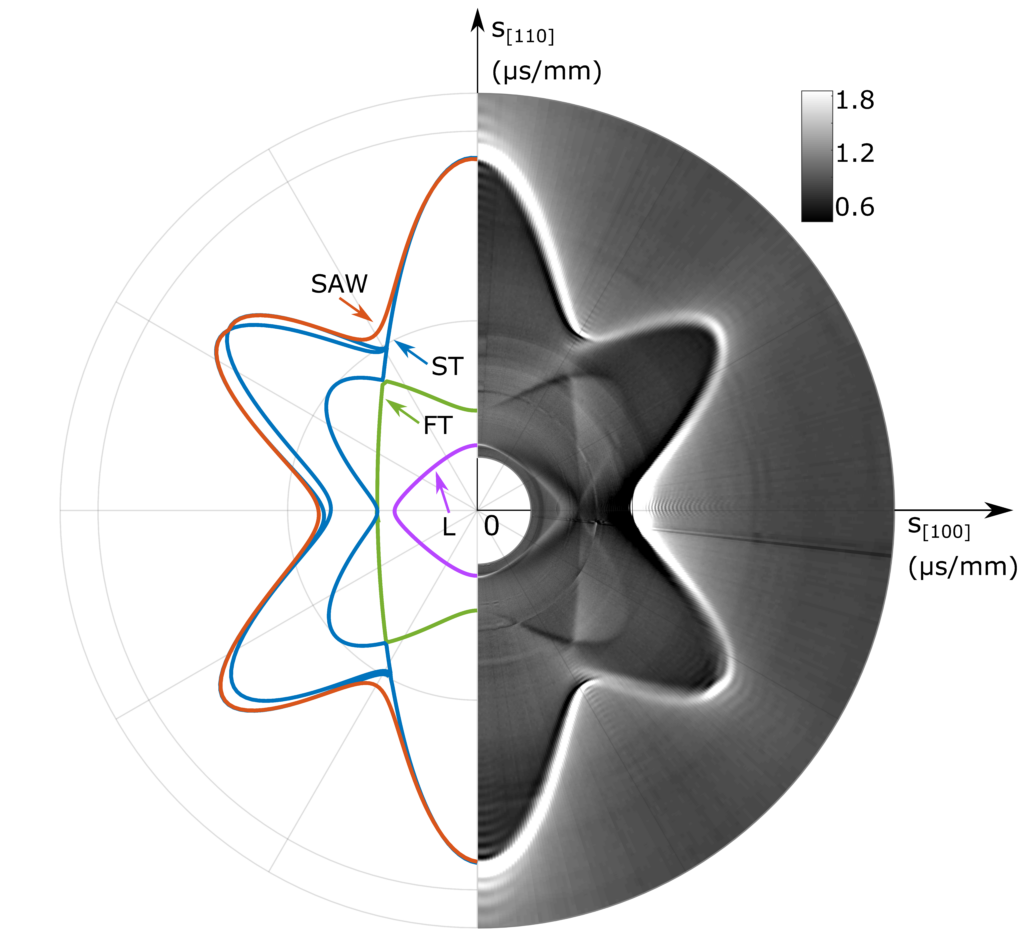
Fig. 1
Transient grating spectroscopy is used for contactless ultrasonic measurement of surface acoustic wave velocities with a constrained wavelength on a free surface of the material. Currently, two optical setups are available in the laboratory. The first one allows the construction of the angular distribution maps of acoustic wave velocities via sample rotation. The second one is equipped with a temperature chamber with working temperatures ranging from -190 °C to +600°C. Apart from the further development of the optical setups, the signal processing methodology is being developed, together with the inverse calculation of elastic coefficients.
Measurement of elastic coefficients and their evolution with temperature and stress
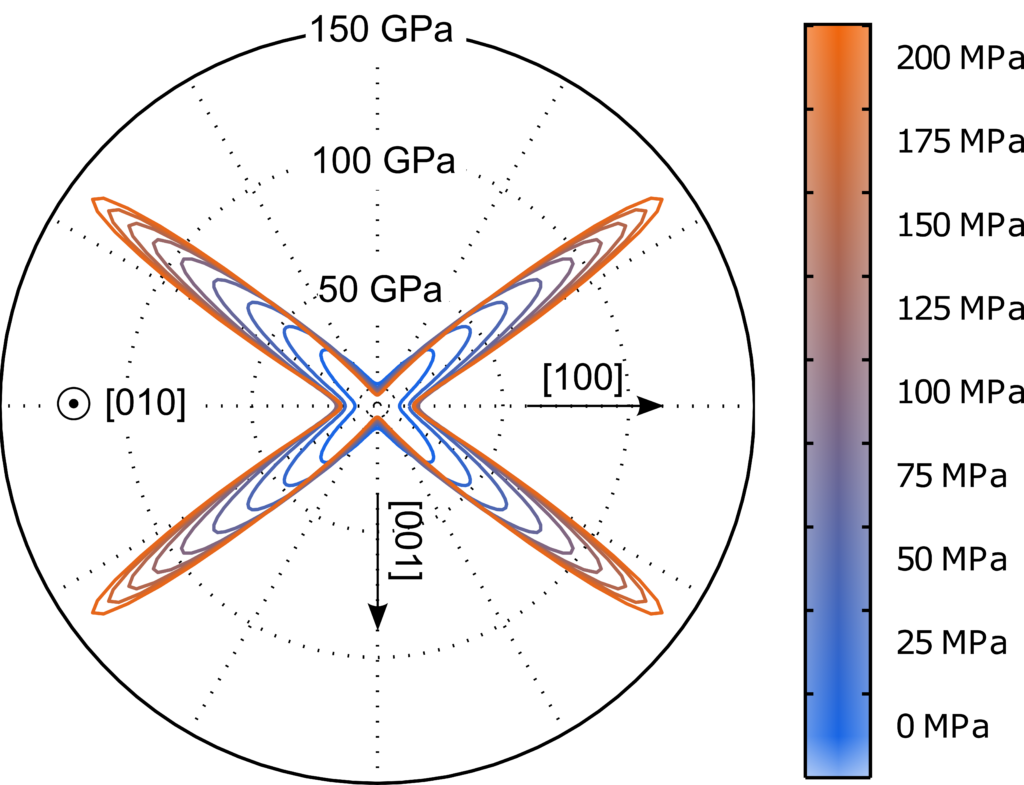
Fig. 2
The angular distributions of surface acoustic wave velocities obtained from the transient grating spectroscopy allow the inverse calculation of the shear elastic moduli. When combined with the temperature chamber measurements, it is also possible to measure the elasticity evolution with temperature. The method was successfully applied for single-crystalline alloys Cu-Al-Ni, Cu-Al-Mn, and Ni-Fe-Ga-Co with strong elastic anisotropy. For ferromagnetic shape memory alloys (e.g., Ni-Mn-Ga), the influence of the external magnetic field might be analyzed, as well as the magneto-acoustic effect.
The Laser Ultrasonic Receiver / Interferometer system allows the shear moduli evolution under tension or compression to be measured. It was successfully used to record the stress-induced martensitic transformation in single-crystalline Ni-Ti or Fe-Pd.
Elasticity measurements of thin films and surface layers
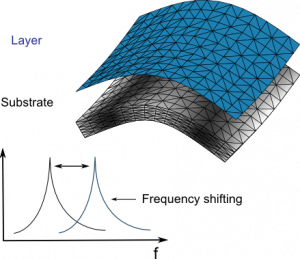
Fig. 3
The elastic coefficients of thin films (≥ 300 nm) are determined by comparing the acoustic response of the thin film on a substrate and of the substrate alone. This method was used for studying the diamond layers (DLC) and thin films of shape memory alloys.
Brillouin spectroscopy
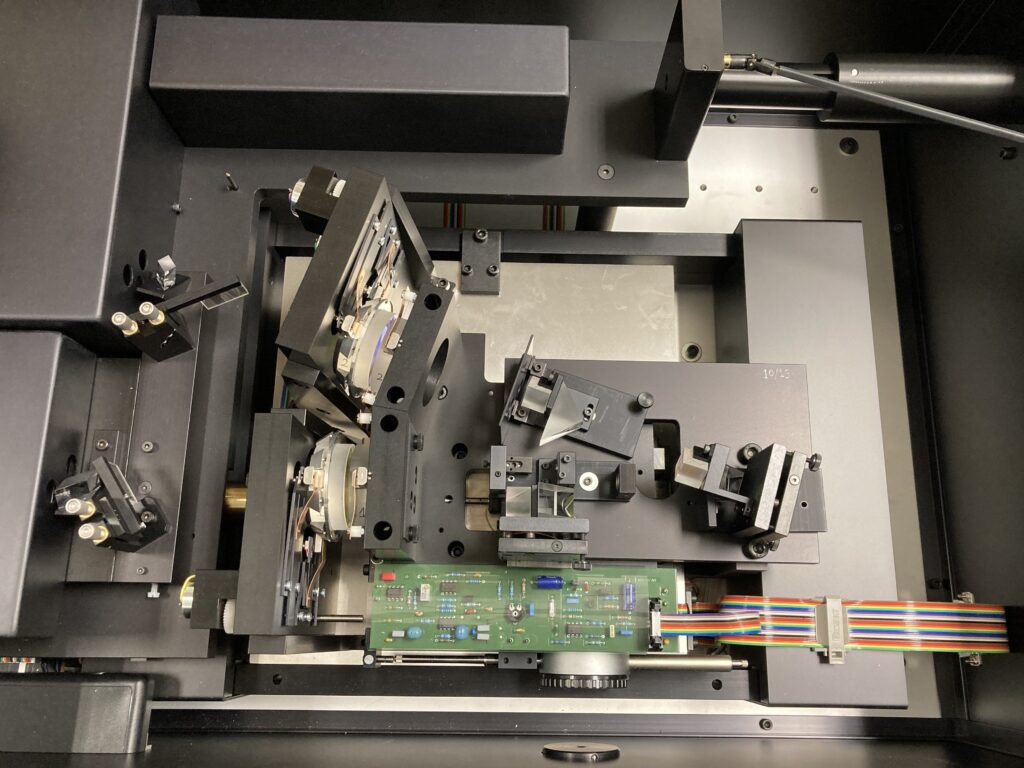
Fig. 4
The experimental method is based on coherent inelastic scattering of light on phonons, allowing measurement of elastic waves with a wavelength of less than 1 µm (long-wave acoustic phonons). It is suitable for studying longitudinal and shear bulk waves with an acoustic frequency of up to 100 GHz and even surface acoustic waves with frequencies above 1 GHz. Such wavelengths and frequencies are necessary, e.g., to characterize the properties of nanomaterials and thin films with the thickness of several tens of nanometers.
All the currently used methods enable contactless and non-destructive measurement of surface acoustic wave velocities, both generated and detected by lasers. From the resulting velocities, the shear elastic constants might be numerically calculated using the inverse method.
Transient grating spectroscopy (TGS)
A characteristic feature of the TGS method is the generation of the narrowband pattern of surface acoustic waves with a strongly constrained propagation direction. The currently employed configuration enables generating waves with wavelengths of 5 µm, 10 µm, and 20 µm via pulsed infrared laser. A continuous green laser is used for detection. Two optical setups are available, differing in the mounting of the studied sample.
Setup A – Rotation stage
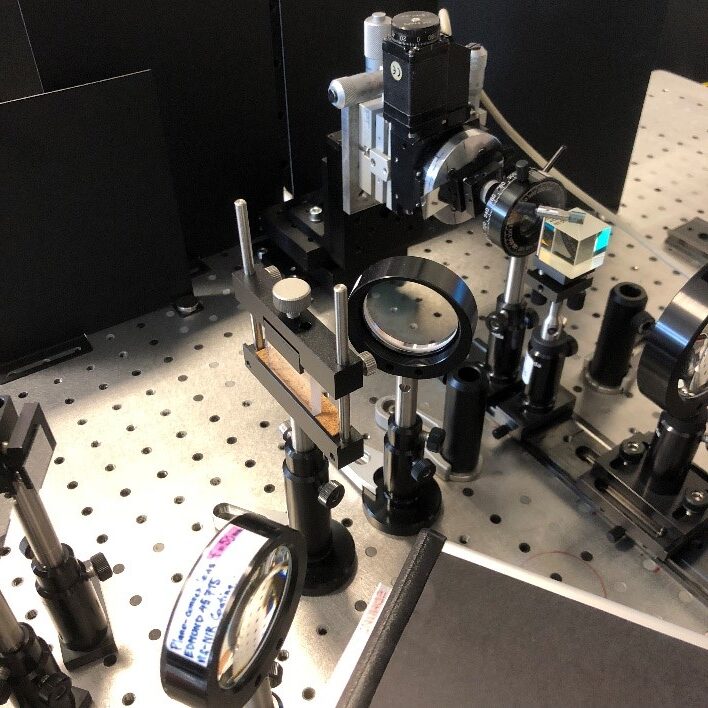
Fig. A - TGS rotation
The system in Fig. A is used for the measurement of anisotropic materials. The sample is mounted on a rotation stage and rotated around the surface normal, enabling the angular distribution of acoustic wave velocities on a single plane to be recorded.
Setup B - Temperature chamber
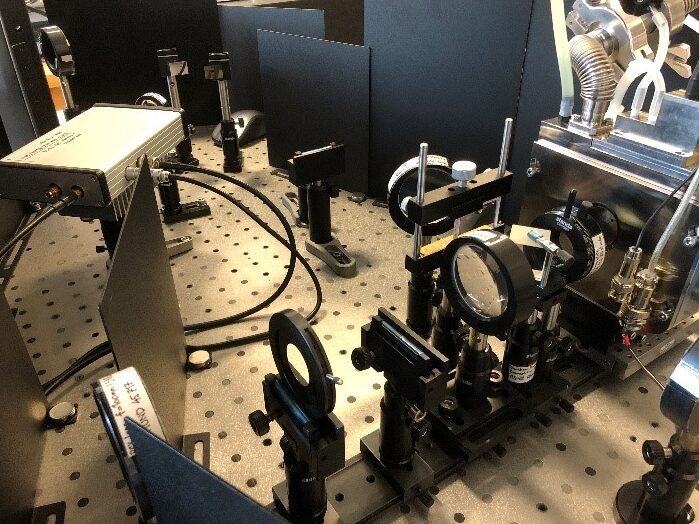
Fig. B - TGS chamber
The system shown in Fig. B is suitable for measuring the changes of elasticity with temperature. The sample is placed in the heating/cooling vacuum stage, where it is exposed to temperatures ranging from -190 °C to +600°C.
Laser Ultrasonic Receiver / Interferometer
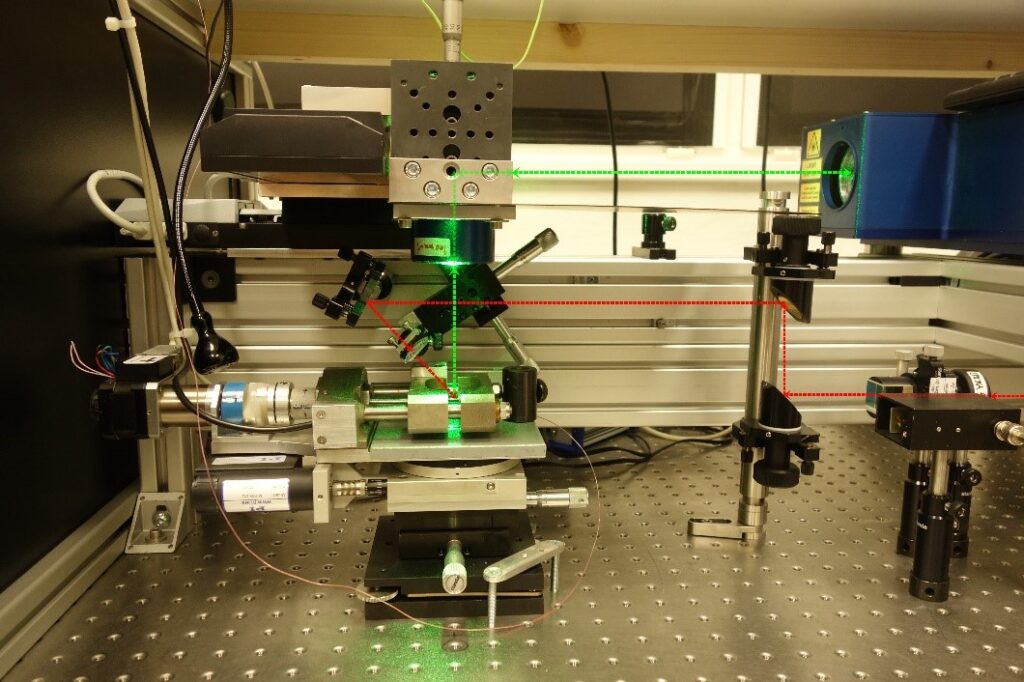
Fig. C - Interferometer-receiver
The method shown in Fig. C is Time-of-arrival-based. The setup enables generating broadband acoustic waves with frequencies ranging from 5 to 500 MHz and fixed propagation direction by an infrared laser focused into a line. The Laser Ultrasonic Receiver is used for the detection. The distance between the wave source and the detection spot is known, and the surface acoustic wave velocities are calculated from the detected time of arrival of the acoustic wave. The sample is placed in the tensile testing machine, where the force of up to 5 kN in compression or 2 kN in tension can be applied. The tensile testing machine lies on a rotation stage, enabling the surface acoustic wave velocities to be measured in different directions. This is especially suitable for materials with prominent elastic anisotropy.
Brillouin spectroscopy
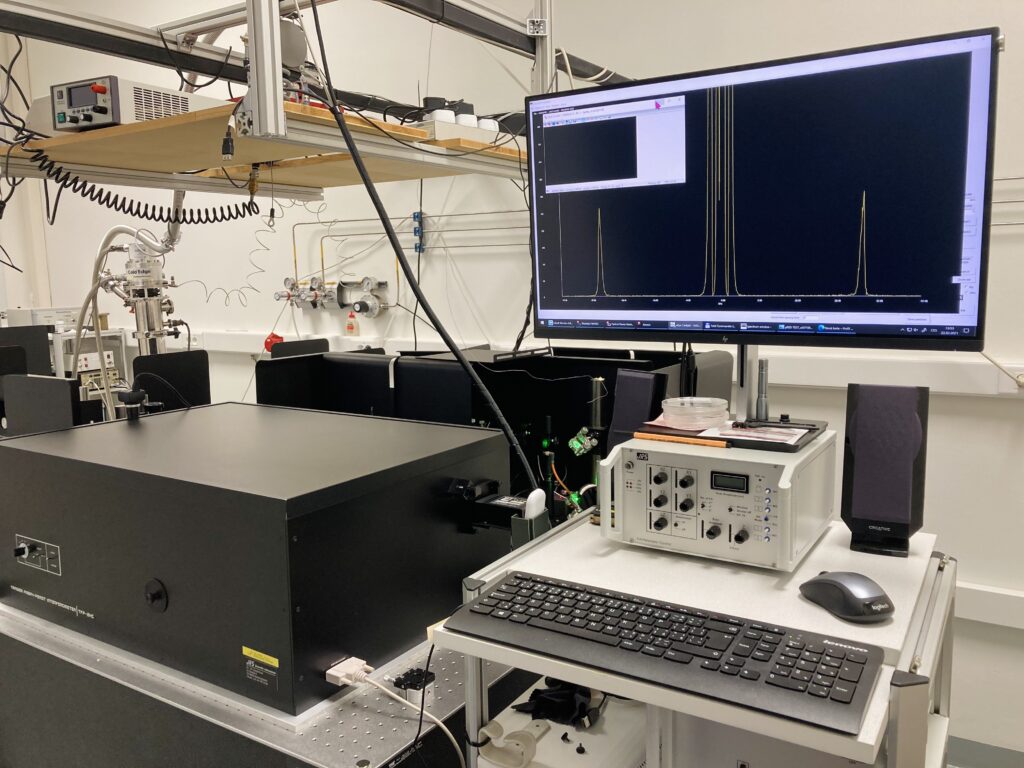
Fig. D - Brillouin spectroscopy
The method is used to evaluate elastic and chemical properties of materials by measuring the energies of acoustic and limit optical phonons with high contrast and resolution. The laboratory is equipped with an optical assembly with a tandem interferometer, a confocal microscope, a temperature chambers system, and helium cryostat for characterization of bulk inorganic and organic materials, layers, and nanostructures in broad temperature interval. Depending on the selected measuring configuration, the method is suitable for both opaque and partially or fully transparent materials, even in the form of layers. The setup enables the detection of frequencies in the order of hundreds of GHz, corresponding to acoustic phonons (the vibrations of crystal lattice). The analysis of optical phonons in the range of tens or hundreds of THz is enabled by combining the Brillouin spectroscopy with modular Raman spectroscope, which detects the Raman scattering.
Doctoral students:
Ing. Tomáš Grabec
- Topic: Numerical modeling in laser-ultrasonic methods
- Supervisor: Ing. Petr Sedlák, Ph.D.
- Start year: 2017
- year of graduation: 2021
- Topic: Microstructure instability in ferroelastics
- Supervisor: doc. Ing. Hanuš Seiner, Ph.D.
- Start year: 2019
- Expected year of graduation: 2023
